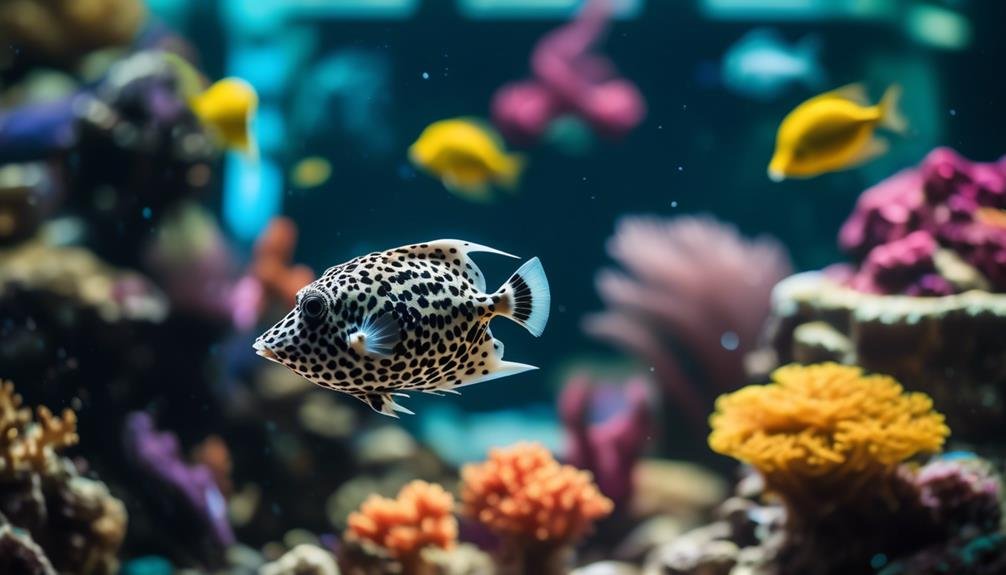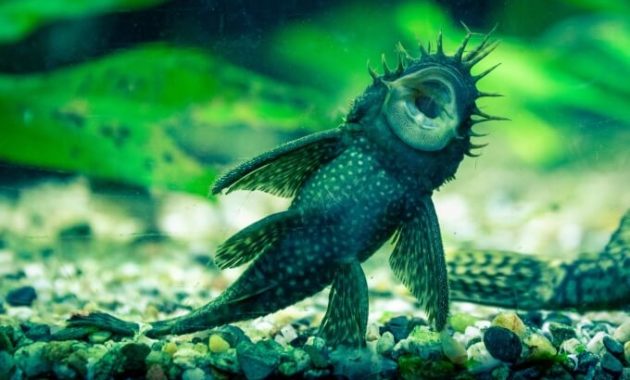
Did you know that the world of boxfish is filled with captivating colors and unique characteristics that make them a stunning addition to your aquarium? These mesmerizing creatures, with their square-shaped bodies and heavy armored scales, are sure to leave you in awe.
But there’s more to discover about boxfish. From their compatibility with other fish to their feeding habits and care requirements, there’s a whole world of fascinating information waiting for you to explore.
So, let’s dive in and uncover the secrets of these enchanting creatures that will make your aquarium truly come alive.
Key Takeaways
- Boxfish are medium to large saltwater fish with a square-shaped body and heavy armored scales.
- They are suitable tank mates for butterflies, clownfish, gobies, damsels, and hogfish.
- Boxfish require a large aquarium with hiding places and open swimming areas, as well as an adequate filtration system.
- Their diet should include a variety of meaty and vegetarian foods, and feeding habits should be monitored to prevent overfeeding.
Boxfish Description
Boxfish are saltwater fish with a medium to large size and a square-shaped body adorned with heavy armored scales. They’re slow swimmers and different species can grow to sizes ranging from 3 to 18 inches.
When it comes to suitable tank mates, you can consider butterflies, clownfish, gobies, damsels, hogfish, parrotfish, and tangs. However, it’s important to avoid aggressive or predatory fish as boxfish can turn aggressive towards their own species.
If you want to keep multiple boxfish, it’s best to keep two or more females together. Keep in mind that boxfish aren’t suitable for reef aquariums due to their tendency to prey on invertebrates and possibly eat coral.
When it comes to maintenance and care, make sure to provide hiding places and open swimming areas in the aquarium, as well as an adequate filtration system.
Suitable Tank Mates

When considering tank mates for your boxfish, it’s important to choose compatible species that won’t pose a threat or become aggressive towards each other. Good tank mates for boxfish include butterflies, clownfish, gobies, damsels, hogfish, parrotfish, and tangs.
It’s best to avoid aggressive or predatory fish that may harm the boxfish. Additionally, boxfish can turn aggressive towards their own species, so it’s recommended to keep two or more females together rather than a male and female pair.
It’s important to note that boxfish aren’t suitable for reef aquariums due to their tendency to prey on invertebrates and potentially eat coral.
Maintenance and Care

To properly care for your boxfish, it is essential to provide the necessary maintenance and attention to ensure their well-being. Boxfish are not suitable tank mates for aggressive or predatory fish, as they emit toxins through their skin when stressed or threatened. They thrive in aquariums with hiding places and open swimming areas, and require an adequate filtration system due to their hearty eating habits and waste production. It is important to provide a balanced diet for boxfish, which includes a variety of meaty and vegetarian foods. Feeding frequency may vary depending on the individual fish, so monitor their feeding habits to prevent overfeeding and maintain water quality. By following these guidelines, you can create a healthy and thriving environment for your boxfish.
| Maintenance and Care |
|---|
| ✓ Avoid aggressive or predatory tank mates |
| ✓ Provide hiding places and open swimming areas |
| ✓ Ensure an adequate filtration system |
| ✓ Offer a balanced diet of meaty and vegetarian foods |
| ✓ Monitor feeding habits and maintain water quality |
Feeding

To ensure the proper nutrition and well-being of your boxfish, it’s important to understand their feeding requirements. Here are some key points to keep in mind:
- Offer a varied diet: Boxfish thrive on a diet that includes both meaty and vegetarian foods. They readily accept shrimp, crab meat, mussels, frozen peas, boiled lettuce, and dried seaweed.
- Provide a balanced diet: It’s important to provide a balanced diet to meet their nutritional needs. This will help keep them healthy and vibrant.
- Monitor feeding habits: Feeding frequency may vary depending on the individual fish. It’s crucial to monitor their feeding habits to prevent overfeeding and maintain water quality.
- Maintain water quality: Boxfish have hearty eating habits and produce waste. To ensure a healthy environment for your boxfish, it’s essential to have an adequate filtration system in place. This will help maintain water quality and keep your boxfish thriving.
General Information

Boxfish, also known as trunkfish, cowfish, and cofferfish, have a community aggressive temperament and require a large aquarium (55 gal+) for their middle swimming region. These saltwater fish have a square-shaped body with heavy armored scales, making them slow swimmers. Different species of boxfish can grow to sizes ranging from 3 to 18 inches.
When it comes to suitable tank mates, boxfish get along well with butterflies, clownfish, gobies, damsels, hogfish, parrotfish, and tangs. However, they should be kept away from aggressive or predatory fish. It’s best to keep two or more females together to avoid aggression within their own species.
Boxfish aren’t suitable for reef aquariums due to their tendency to prey on invertebrates and potentially eat coral. They emit a toxin through their skin when stressed or threatened, therefore, it’s important to provide them with hiding places and open swimming areas.
Boxfish thrive in aquariums with an adequate filtration system, as they’ve hearty eating habits and produce a significant amount of waste. In terms of feeding, boxfish have a varied diet consisting of meaty and vegetarian foods. They accept shrimp, crab meat, mussels, frozen peas, boiled lettuce, and dried seaweed. It’s crucial to provide them with a balanced diet and monitor their feeding habits to prevent overfeeding and maintain water quality.
Saltwater Fish

What makes saltwater fish a unique addition to your aquarium? Here are four reasons why they’re an exciting choice:
1) Vibrant Colors: Saltwater fish are known for their stunning and vibrant colors. From royal blues to fiery oranges, these fish can bring a burst of color to your tank, creating a visually appealing and captivating display.
2) Intricate Patterns: Many saltwater fish boast intricate patterns on their scales, adding a touch of elegance and sophistication to your aquarium. Watching these patterns move gracefully through the water can be a mesmerizing experience.
3) Unique Shapes: Saltwater fish come in a variety of shapes, from sleek and streamlined to odd and unconventional. Their unique body structures make them stand out and can be a conversation starter for anyone admiring your aquarium.
4) Diverse Species: The world of saltwater fish is incredibly diverse, with countless species to choose from. This diversity allows you to create a personalized and unique aquarium, showcasing a wide range of beautiful and fascinating fish.
With their vibrant colors, intricate patterns, unique shapes, and diverse species, saltwater fish can truly transform your aquarium into a mesmerizing underwater world.
Size and Body Characteristics

Saltwater fish of the Boxfish species exhibit a range of sizes and unique body characteristics. These fish are medium to large in size, with different species growing to sizes ranging from 3 to 18 inches.
One distinguishing feature of Boxfish is their square-shaped body, which is covered in heavy armored scales. This gives them a distinct appearance and provides protection against predators.
Additionally, Boxfish are known for being slow swimmers. Their body shape and swimming style make them well-suited for navigating through coral reefs and rocky areas.
Swimming Behavior

With their unique body characteristics and medium to large size, Boxfish aren’t only visually appealing but also fascinating to observe in their swimming behavior. Here are four reasons why their swimming behavior is truly captivating:
- Graceful and Slow Movements: Boxfish have a mesmerizing way of gliding through the water with their square-shaped bodies. Their slow and deliberate movements exude a sense of elegance and tranquility.
- Hovering Abilities: Unlike many other fish, Boxfish have the ability to stay suspended in the water column without much effort. They can hover in one place, making them a captivating sight to watch in your aquarium.
- Unique Fin Movements: Boxfish use their pectoral fins to steer and maneuver through the water. The way their fins move in unison creates a beautiful and rhythmic motion that’s a treat for the eyes.
- Startling Speed Burst: Although generally slow swimmers, Boxfish can surprise you with sudden bursts of speed when they need to escape from a potential threat. Witnessing their rapid acceleration is a thrilling sight that showcases their agility.
Coral Predation and Reef Compatibility

To ensure the well-being of your coral and the overall compatibility of your reef aquarium, it is essential to consider the coral predation tendencies of Boxfish. While Boxfish are known for their vibrant colors and unique appearances, they can pose a threat to the coral in your tank. These slow swimmers have a tendency to prey on invertebrates, including coral, making them unsuitable for reef aquariums. To help you understand the potential risks, here is a table highlighting the coral predation tendencies of Boxfish:
| BoxFish Species | Coral Predation Tendencies | Reef Compatibility |
|---|---|---|
| Yellow Boxfish | High | Not suitable |
| Cowfish | Moderate | Not suitable |
| Pinecone Boxfish | Low | Not suitable |
As you can see, all species of Boxfish have some level of coral predation tendencies, making them incompatible with a reef aquarium. It is important to consider alternative tank mates that won’t harm your precious coral and maintain the health and beauty of your reef environment.
Aggression and Social Behavior

Boxfish exhibit distinct aggression and social behavior within their aquarium environment. Here are four important things you need to know about their aggression and social behavior:
- Aggression towards own species: Boxfish can become aggressive towards their own kind, especially males. It’s best to keep two or more females together to reduce aggression.
- Suitable tank mates: Although boxfish can be aggressive, they can coexist with certain species. Good tank mates include butterflies, clownfish, gobies, damsels, hogfish, parrotfish, and tangs. However, it’s important to avoid aggressive or predatory fish.
- Not suitable for reef aquariums: Boxfish have a tendency to prey on invertebrates and may eat coral. Therefore, they aren’t recommended for reef aquariums.
- Hiding places and open swimming areas: To minimize aggression and provide a suitable environment for boxfish, it’s important to have plenty of hiding places and open swimming areas in the aquarium. This will allow them to establish territories and reduce stress.
Female Boxfish Grouping

When keeping female boxfish together in an aquarium, it’s important to establish a harmonious social dynamic.
Female boxfish can be kept together in a group, but it’s essential to introduce them gradually to minimize aggression. It’s best to keep two or more females together to spread out any potential aggression. However, it’s crucial to monitor their behavior closely to ensure that one female isn’t dominating the others excessively.
Providing ample hiding places and open swimming areas can also help alleviate aggression and provide a sense of security for the females.
Remember to avoid keeping aggressive or predatory fish with female boxfish, as it can lead to stress and potential harm.
Compatibility With Aggressive or Predatory Fish

If you want to ensure a peaceful and stress-free environment for your female boxfish grouping, it’s important to carefully consider the compatibility of aggressive or predatory fish. Here are four reasons why you should avoid keeping aggressive or predatory fish with your boxfish:
- Safety: Aggressive or predatory fish can pose a threat to the delicate boxfish, which are slow swimmers and have heavy armored scales. Keeping them together may result in injuries or even fatalities.
- Stress: Boxfish emit toxins through their skin when stressed or threatened. The presence of aggressive or predatory fish can cause constant stress for the boxfish, leading to the release of toxins and potential health issues.
- Feeding Habits: Boxfish are known to prey on invertebrates and may even eat coral. Introducing aggressive or predatory fish can create competition for food, causing inadequate nutrition for the boxfish.
- Peaceful Environment: Boxfish thrive in aquariums with hiding places and open swimming areas. Having aggressive or predatory fish in the same tank can disrupt their natural behavior and prevent them from feeling safe and comfortable.
Toxin Emission and Stress Response

To ensure the well-being of your boxfish, it is important to understand how their stress response can lead to toxin emission. When boxfish feel threatened or stressed, they have the ability to emit toxins through their skin. This defense mechanism helps protect them from predators in the wild, but it can be harmful to other tank inhabitants. To prevent toxin emission, it is crucial to provide a stress-free environment for your boxfish. This includes ensuring they have enough hiding places and open swimming areas in their aquarium. Additionally, avoid aggressive or predatory tank mates that may cause stress. By understanding their stress response and taking appropriate measures, you can ensure the health and happiness of your boxfish.
| Toxin Emission and Stress Response | |
|---|---|
| Stress Response | Toxin Emission |
| Boxfish emit toxins when stressed or threatened | Defense mechanism to protect against predators |
| Provide a stress-free environment to prevent toxin emission | Ensure enough hiding places and open swimming areas |
| Avoid aggressive or predatory tank mates | Promote a peaceful and calm environment |
Habitat Requirements

Boxfish have specific requirements for their habitat to ensure their well-being and thriving in captivity. Here are the key factors to consider when setting up a tank for your boxfish:
- Tank Size: These medium to large-sized fish require a spacious aquarium of at least 55 gallons or more. Providing ample swimming space is essential for their overall health and happiness.
- Water Quality: Boxfish thrive in well-maintained aquariums with a robust filtration system. Regular water changes and monitoring of water parameters, such as temperature, salinity, and pH, are crucial for their well-being.
- Hiding Places: These slow swimmers appreciate having hiding spots in their habitat. Rocks, caves, and live rock structures can provide them with a sense of security and help reduce stress.
- Compatible Tank Mates: Choose tank mates that are peaceful and non-aggressive. Butterflies, Clownfish, Gobies, and Tangs are suitable companions for boxfish, while aggressive or predatory fish should be avoided.
Feeding Habits and Diet Diversity

When providing food for your boxfish, it’s important to offer a diverse diet to ensure their nutritional needs are met. Boxfish have a varied diet that includes both meaty and vegetarian foods. They readily accept shrimp, crab meat, mussels, frozen peas, boiled lettuce, and dried seaweed.
It’s crucial to provide a balanced diet to promote their overall health and well-being. Feeding frequency may vary depending on the individual fish, so it’s important to monitor their feeding habits to prevent overfeeding and maintain water quality.
Boxfish have hearty eating habits and can produce a significant amount of waste, so it’s recommended to have an adequate filtration system in place. By offering a diverse diet, you can ensure that your boxfish remains healthy and vibrant in your aquarium.
Frequently Asked Questions
How Do Boxfish Emit Toxins Through Their Skin When Stressed or Threatened?
Boxfish emit toxins through their skin when stressed or threatened. This is their defense mechanism to deter predators. When they feel threatened, they release toxins that can be harmful to other fish in the aquarium.
What Are the Habitat Requirements for Boxfish in an Aquarium?
To provide the right habitat for your boxfish in an aquarium, you should have a large tank (55 gal+), with hiding places and open swimming areas. Avoid aggressive or predatory tank mates and ensure a proper filtration system.
How Often Should Boxfish Be Fed and What Should Their Diet Consist Of?
Boxfish should be fed a varied diet consisting of meaty and vegetarian foods. Offer shrimp, crab meat, mussels, frozen peas, boiled lettuce, and dried seaweed. Monitor their feeding habits to prevent overfeeding and maintain water quality.
Are Boxfish Compatible With Aggressive or Predatory Fish in an Aquarium?
Boxfish are not compatible with aggressive or predatory fish in an aquarium. They may turn aggressive towards their own species and emit toxins when stressed. It’s best to keep them with peaceful tank mates.
What Is the Swimming Behavior of Boxfish in the Aquarium?
Boxfish are slow swimmers with a square-shaped body and heavy armored scales. They prefer open swimming areas and hiding places in the aquarium. Their swimming behavior is unique and adds a colorful touch to your tank.
What Makes Boxfish a Colorful Addition to Your Aquarium?
The boxfish is a vibrant and captivating addition to your aquarium. Its striking colors and unique body shape can add a lively and dynamic energy to your aquatic environment. Not only that, but the boxfish also brings a pop of color and liveliness to the fascinating world of flounder fish.
Conclusion
So, if you’re looking to add a vibrant and captivating fish to your aquarium, look no further than the intriguing world of boxfish. With their distinctive square-shaped bodies and variety of species, they’re sure to capture your attention.
Just remember to choose suitable tank mates, maintain a tranquil environment, and provide a balanced diet. Get ready for a colorful and captivating addition to your aquarium with boxfish!




